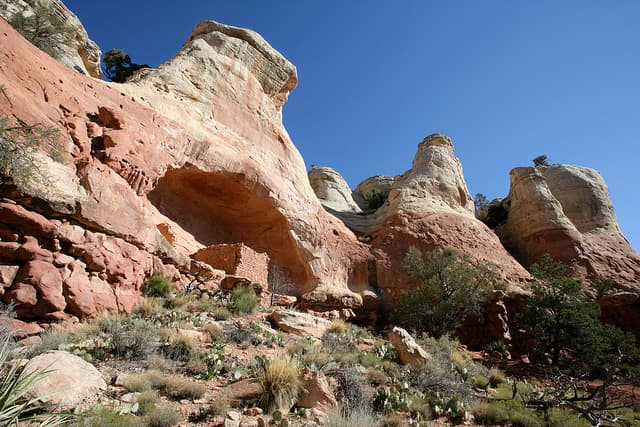
Canyons of the Ancients National Monument in southwestern Colorado contains the highest known concentrations of archaeological sites in the United States, with more than 6,000 cultural sites across 176,000 acres. It was this unequaled cultural heritage that led President Bill Clinton to designate the area a national monument in 2000.
Now the designations of 24 national monuments, including Canyons of the Ancients, are under review by the administration of President Donald J. Trump. In an executive order signed Wednesday, he gave Interior Secretary Ryan Zinke 120 days to review and make recommendations on the fate of national monuments larger than 100,000 acres that were created since 1996 or expanded since 1996.
During a signing ceremony at the Interior Department, Trump referred to the national monuments as "a massive federal land grab." He said the order would end "another egregious abuse of federal power" and "give that power back to the states and to the people where it belongs."
National monuments are created on land that already belongs to the federal government, like U.S. Forest Service or Bureau of Land Management holdings. National monument designation brings more careful management, sometimes restrictions on certain uses of the land and more resources to protect these environmentally or culturally sensitive locations.
It's the potential loss of those extra resources that could most affect a site like Canyons of the Ancients if it stopped being a national monument.
"More looting of cultural sites, more poaching of wildlife, more off-road use," said Carrie King, associate director of the Durango-based Great Old Broads for Wilderness, of the likely impacts. "It wouldn't be monitored in the same way."
Conservationists are appalled.
Zinke, who said during his confirmation hearings that he opposes a transfer of federal lands to the states, said he has not reached any foregone conclusions about any of the monuments. But Scott Braden, wilderness and public lands advocate at Conservation Colorado, said it's hard to imagine why Trump would order a review and use the language he did if he didn't intend to roll back at least some of the designations. Braden said he was put in mind of the famous adage from Russian playwright Anton Chekhov: Don't show the gun in the first act unless you're going to fire it in the third act.
"This is attacking conservation protections that have been hard-won for the last 20 years," Braden said. "... I take it as the opening salvo and attack on national monuments. I take it both literally and seriously. Even though it's a first step, the order leaves the door open to presidential and legislative action based on the recommendations."
While other presidents have modified national monuments, no president has ever undone a monument designation. Such a move is likely to be challenged in court and could face opposition in Congress, including from some Republicans. Polls consistently find high levels of support for public lands in many parts of the West.
"We're baffled and we're infuriated because we don't understand why a president who touts economic prosperity would take away the very thing that is driving the economy of these rural communities," King said. "... It's our cultural heritage and our way of life. We will fight this executive order. We consider this move unwanted and unwarranted and frankly, to use their words, it's government overreach."
This is basically Utah's fault.
Utah has been the epicenter of the public lands debate, with many elected officials advocating for the federal government to turn over lands it manages and owns to the state. Some even want to see that land privatized. The Outdoor Retailer show recently announced it's leaving Utah over the state's position on public lands issues -- the recreation industry relies on access to public lands and on not having them too despoiled by other economic activity -- and Colorado is trying to woo the show.
Utah has asked the Trump administration to overturn the designation of Bears Ear National Monument, an incredibly contentious monument created by Obama in the final weeks of his administration. Opponents contend the monument was created over the objections of neighboring communities and harms their economic prospects. There's always the question, of course, of whose voice gets to speak for the community. Tribal leaders worked on the designation for years, and they promised to fight the executive order.
By reaching back to 1996, the executive order includes Grand Staircase-Escalante National Monument, also in Utah, and Zinke seemed to acknowledge to reporters that those bookends were intentional.
Colorado's delegation won't necessarily be as supportive of removing national monument status.
Zinke has 45 days to complete a preliminary review, which he said will focus on Bears Ear, and 120 days to make final recommendations.
What exactly is a national monument?
The 1906 Antiquities Act, enacted under President Theodore Roosevelt, empowers the president to declare as national monuments any landmarks, structures and other "objects of historic or scientific interest" on land owned or controlled by the federal government. Roosevelt established 18 monuments, including the Grand Canyon in Arizona and Devil's Tower in Wyoming. Most presidents since then have designated additional monuments. Congress has created others.
Most monuments are overseen by the National Park Service. Some are cared for by the federal Bureau of Land Management, the Fish and Wildlife Service or the Forest Service. Each agency has policies for protecting the land while also allowing some public use.
Canyons of the Ancients wasn't nearly as contentious as Bears Ear, but there were concerns.
In an interview with Dryland Community Radio earlier this month, LouAnn Jacabson, who managed the monument from its founding in 2000 to 2010, described the early opposition that assumed the worst of BLM.
"I think there was a lot of fear that we were going to abolish grazing, shut down oil and gas development," she said. "People even said we were going to put up gates ... and shut them off from their property."
And those fears didn't necessarily abate over time.
"The people who were fearful remained fearful, but we were able to demonstrate that I wasn't lying, that no gates were put up, that people were allowed to access their private property," she said. "Some of the grazing permittees were also upset by the cuts we made in grazing, but they were allowed to continue grazing."
Jacobson said her goal was always that the monument be in better shape than when it was established. BLM carried out land health assessments and in many cases reduced the number of cattle that could be grazed under particular allotments. But Jacobson said the intent was to have grazing be more sustainable over time.
Oil and gas development also continues within the monument, particularly by Kinder Morgan, but BLM works with companies to mitigate the impacts on both the environment and cultural sites.
Megg Heath, a retired archaeologist and educator, served as the National Heritage Education Lead for the BLM and worked out the Anasazi Heritage Center before and after the national monument designation. She was less directly involved with Canyons of the Ancients after 2002.
BLM monument designation "doesn't change the management of the land as drastically as if it were a national park," she said.
Heath said there were environmental and antiquities protections in place before the monument designation, as there are on all BLM lands. In fact, some of the changes to grazing regulations within the monument actually applied to all BLM lands, even though local ranchers sometimes blamed the change in status for restrictions on their grazing practices. "In-holdings," private land within or bordering the monument, was bought out through a negotiated process, not "grabbed," Heath said.
The monument designation also meant the area got more staff -- a manager, law enforcement rangers, educational staff -- and that helps manage the impact of all the tourists who visit.
Without the monument status, "some of the special protections would go away. It could be used as an excuse by some people to say we want more mineral leases, we want more grazing."
The monument has become a source of economic activity in its own right, said Heath, who retired from BLM in 2015 but still lives in Montezuma County.
"This has always been a poorer area that has struggled with the boom and bust from oil and gas," Heath said. "More recreation-related jobs help balance out some of the big swings."
A 2014 study by the nonprofit research group Headwaters Economics found that indicators such as employment, population and per-capita income held steady or improved in sections of the West where monuments larger than 10,000 acres had been established since 1981.
While the order focuses on national monuments that are more than 100,000 acres in size, the wording leaves open the possibility that smaller monuments could also be reviewed if the administration feels there wasn't sufficient community input into the decision. In Colorado, those include Browns Canyon National Monument, designated by Obama in 2015 along the upper Arkansas River, and Chimney Rock National Monument, designated by Obama in 2012 in the San Juan National Forest.
The Associated Press contributed to this report.












